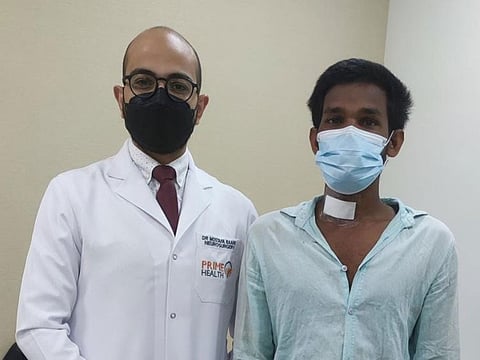Watch: Five-hour spinal surgery in Dubai saves worker from quadriplegia
Timely decompression of spine helps 26-year-old expat get back on his feet immediately

Dubai: A 26-year-old expatriate blue-collar worker who had suffered a debilitating spinal injury while at work, was saved from turning a quadriplegic (paralysed neck downwards) by timely intervention by a neurosurgeon at a Dubai hospital. The surgeon conducted a more-than five-hour surgery to save the life and limb of the worker.
‘My whole body went numb’
It was just a day away from New Years’ Eve. Krishna Kumar Dukhi Prasad, 26, the youngest of three sons in a family of five children, hailing from Uttar Pradesh, India, was at work. As part of his routine work at the factory in UAE, he was transferring heavy glass sheets with other workers, from the truck to the conveyor belt. His job was to assist in lifting of glass on the forklift. He told Gulf News: “My colleagues and I were in-charge of this work on December 30, with the assistance of harness belts attached to the fork-lift. I was looking forward to the change of the year. I really did not know that such a fate awaited me just before the change of the year. Suddenly, the belt carrying the glass sheets snapped and glass sheets weighing two-four quintals fell on my shoulders. I fell to the ground and though I did not lose consciousness, I immediately sensed that my whole body had gone numb. I was conscious, but could not move,” recounted Kumar.
Spinal-cord injury
Dr Mostafa Rafaat, specialist neurosurgeon from Prime Hospital explained: “On the night of October 30, the patient was brought into the Emergency section. His vertebral bone, C-5, had dislocated and the next one, C-6, was heavily compressed on the spinal cord. The patient would most certainly have turned a quadriplegic with such a grave injury. However, quick thinking by the factory staff helped his case tremendously. They did not move him at all, put a neck collar and immediately called the ambulance. Immediate medical help saved him.”
Dr Rafaat carried out a Corpectomy, where he adjusted the dislocated vertebra and removed the compressed C-6 vertebra to replace it with an expandable titanium cage and decompressed the spinal cord. The patient, who was in the operation theatre from 10pm-3am, was able to stand up on his feet the next morning.
Patient would have turned quadriplegic
Dr Rafaat explained: “This patient was brought in quickly enough to the hospital, so he suffered no motor loss. We were able to replace his compressed vertebra with this state-of-the-art new expandable titanium device. The patient recovered his lost sensation and that saved him from becoming a quadriplegic.”
Kumar, who has been going to the hospital alone for follow-up since being discharged, confirmed that he had no pain and although still on sick leave, he hoped to resume work by early next month.
What is corpectomy?
A corpectomy is a surgical procedure where the surgeon excises the damaged vertebrae and the intervertebral discs that compress the spinal cord and nerves and cause numbness. The expandable titanium device that is used to replace the excised vertebrae is flexible and with time it fuses with the rest of the spinal anatomy, providing complete support.
This kind of device is extremely helpful in treating cases of spinal tumours, too, where surgeons have to excise the tumour and underlying vertebrae, but are able to replace it with this device and reconnect with the spine to prevent a patient from suffering a permanent damage.
Sign up for the Daily Briefing
Get the latest news and updates straight to your inbox



